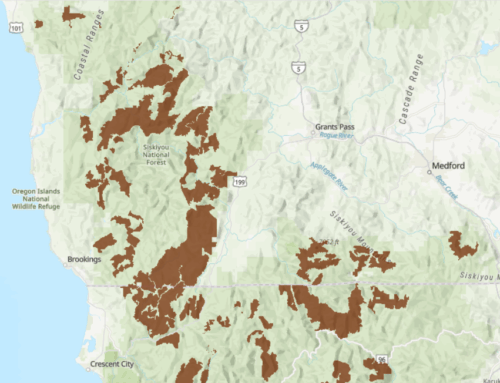The Conservation Column
By Pepper Trail
As we move toward spring, let’s continue to celebrate the positive (and how delightful it is to have positives to celebrate!). In this column I highlight three proposals that, if enacted, would represent tremendous victories in long-running conservation struggles.
The first proposal is the River Democracy Act (RDA). Introduced by Senator Ron Wyden and co-sponsored by Senator Jeff Merkley among others, this would add nearly 4,700 miles of Oregon’s free-flowing streams to the National Wild and Scenic Rivers System. This would expand 42 existing Oregon wild and scenic rivers (WSRs) and establish 81 new ones. Here in southern Oregon, newly protected rivers and expanded river segments would include the Rogue, Illinois, Rough and Ready, Applegate, Little Applegate, Chetco, Jenny Creek, and Scotch Creek. In addition, lakes would now be included in the designation, including Babyfoot Lake in the Siskiyous and Parsnip Lakes in the Cascade-Siskiyou National Monument.
One of the most important provisions of the River Democracy Act is that it would prohibit all mining not only on the newly designated WSRs, but also on all “scenic” and “recreational” river segments established previously. This is especially vital for Rough and Ready Creek, a watershed of unmatched botanical diversity that has been targeted by many major mining proposals over the years. The legislation would also increase the protected buffers to an average of half a mile on each side of the streams. Finally, it is written to specifically include the headwaters of these streams, fixing problematic ambiguity in the usual language conferring protection “from the headwaters.”
While it is early days for this legislation, there is good reason to hope that it will be enacted into law. It has powerful co-sponsors, including Raul Grijalva, the chair of the Committee on Natural Resources in the House of Representatives. And recent polling indicates that an amazing 87% of Oregonians support establishment and expansion of more wild and scenic rivers – including 75% of Republicans. Come on, Congressman Bentz: make your constituents happy and become a co-sponsor now!
The second proposal is before the Oregon Legislature: HB 2843, which would prohibit the taking of beavers on fed-eral land in the state. Our own Pam Marsh is a chief sponsor of this bill. Beavers are unmatched natural engineers and provide tremendous ecological benefits by creating wetlands and ponds that store surface and groundwater for slow and sustained release. The riparian areas surrounding beaver ponds are habitat for many neotropical migrant birds, including Willow Flycatchers, Yellow Warblers, Warbling Vireos, and Bullock’s Orioles.
An economic analysis shows that the market and non-market benefits of passing this bill are worth hundreds of millions of dollars in ecosystem services and restoration savings. These benefits would increase in value over time. The proposed legislation would affect fewer than 170 beaver trappers and hunters in Oregon. Between 2000 and 2018, these trappers killed over 58,000 beavers in the state.
HB 2843 would affect about 32 million acres in Oregon, or roughly 50% of the state. It is important to emphasize that this proposal would not restrict the ability of federal land managers to manage beaver-infrastructure conflicts. It would also not apply to private lands.
The biggest hurdle faced by HB 2843 is simply getting a hearing. It has been assigned to the House Committee on Agriculture on Natural Resources, which has also been assigned around 100 other pieces of legislation. Thus, HB 2843 faces stiff competition for time and attention. If a bill does not get a hearing, it “dies” in committee, and will not move forward during this legislative session. RVAS is strongly supporting the bill and advocating that it gets the attention it deserves.
The final positive proposal is just that – a proposal, and not yet a written piece of legislation. But it is highly significant in that it is an attempt by a Republican legislator to break the decades-long deadlock around the salmon-killing dams on the Snake River. This proposal has been put forth by Congressman Mike Simpson of Idaho. Given Simpson’s very conservative record, it is highly significant that he has stated: “I am certain that if we do not remove [the lower Snake River dams], our salmon and steelhead are on a certain path to extinction.”
Simpson is proposing a $33.5 billion (yes, billion) package of infrastructure investments that would remove the four lower Snake River dams and advance salmon recovery, clean energy, agriculture and economies around the region, and honors treaties and responsibilities to Northwest tribes.
The high price tag is due to sweeteners for a dizzying array of interest groups. Dam removal itself is expected to cost “only” $1.4 billion. On the conservation side, the proposal includes $3 billion for watershed partnerships, $600 million for sturgeon and lamprey conservation, and $1.4 billion various investments in salmon. It would also include such things as $10 billion for energy replacement from the removed dams, $2.8 billion for replacement of lost wheat barging and rail shipping, and $200 million for compensating Lower Snake River ports. Something for everyone, in other words.
Some of the proposed payouts are hard to swallow, but as famed Oregon environmentalist Andy Kerr is fond of saying, “It’s only money.” Months or years of negotiation will be needed before Simpson’s proposals are shaped into actual legislation, but this is likely the last, best chance to remove the lower Snake dams and save these endangered salmon runs. We will continue to monitor this proposal as it moves forward.



Leave A Comment
You must be logged in to post a comment.